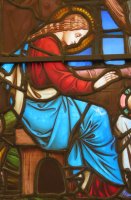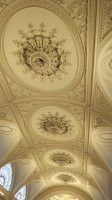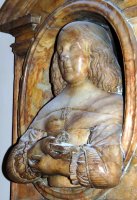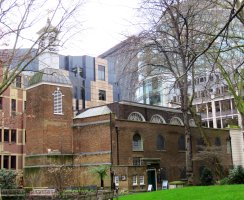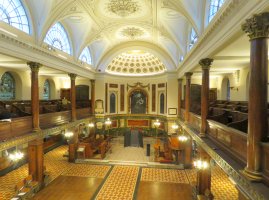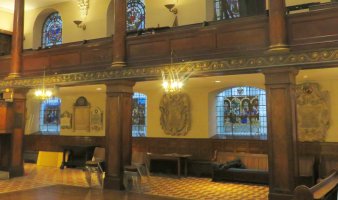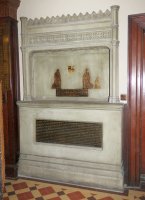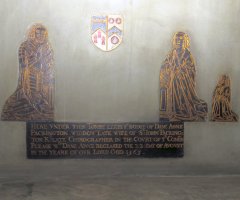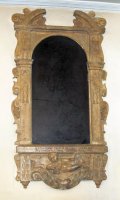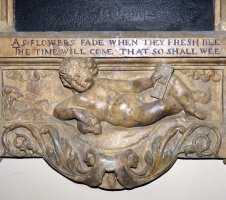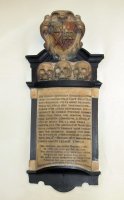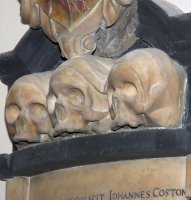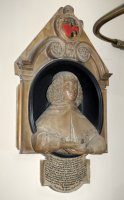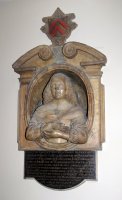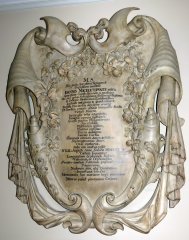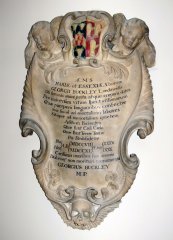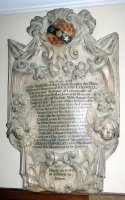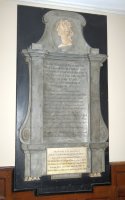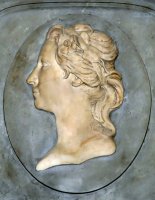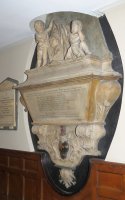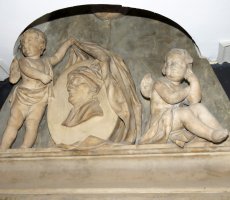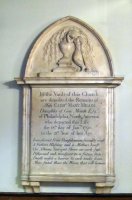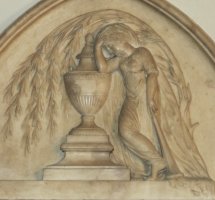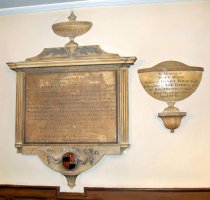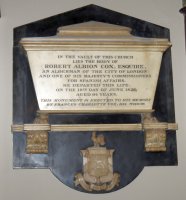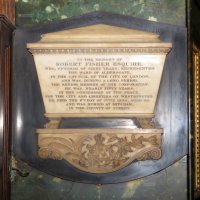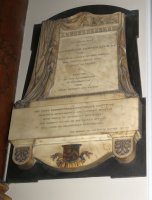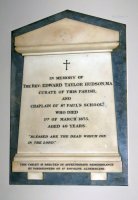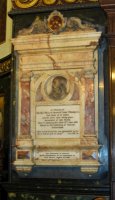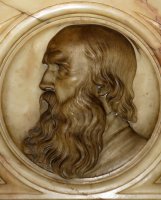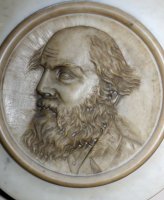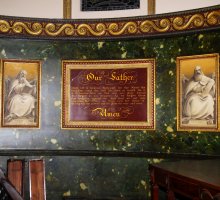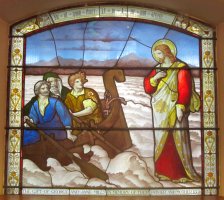St Botolph Aldersgate Church - Monuments
The City Church of St Botolph Aldersgate, rebuilt in the late 18th Century, has an elegant contemporary interior, and around two dozen monuments, including a great 16th Century altar tomb, several 17th Century pieces including two portrait busts, one grand and several lesser 18th Century panels, as well as a number of later, simpler panels. Not to be confused with the similarly named St Botolph Aldgate. If you want the 10-minute visit version of this page, click here.
St Botolph Aldersgate, 1790-91.
St Botolph Aldersgate stands in Postman’s Park, a few minutes stroll north of St Paul’s Cathedral. It is a relatively small building of brick, with a small tower bearing a dome and wooden spire, and a Palladian Classical frontage to Aldersgate Street, with pediment, coupled Ionic pillars, and Venetian window. The medieval Church on the site had survived the Great Fire of London, but then was allowed to decay to the point where it was pulled down. The current Church was put up in 1790-91, keeping some existing wall from the old building, and with that wooden steeple apparently based on the one on the previous tower, which itself had been rebuilt in 1627. The architect was Nathaniel Wright, who was one of the district surveyors for the City of London. The Classical east façade to Aldersgate, much criticised, dates somewhat later than the rest of the Church, from 1831.
The decoration has been reserved for the perfectly preserved interior, which is of basilica shape, with galleries to each side, all in rich wood and marble, and with beautiful vaulted and ribbed ceilings with decorative work. It has been compared to All Hallows London Wall, by the architect George Dance the Younger (though that too was much sneered at in its time). It is this interior that most visitors will come to see, however the monuments include some older ones taken from the previous church, augmented with more modern panels, quite a few signed by their makers, and with a few more attributed by Geoffrey Fisher of the Conway Library. There are around two dozen monuments in all, half of which are from the previous church. We take them in date order - click on the pictures to enlarge.
Monuments
Dame Anne Packington, d.1563. An altar tomb with a recess under a canopy above, within which are brasses of Dame Anne and her (deceased) husband Sir John Packington, and a shield of arms (pictures above). They kneel facing slightly inwards towards each other, hands raised in prayer, each with their faldstool or prayer desk, with opened book. Sir John wears armour but is bareheaded, with wavy hair down to the shoulders, beard and whiskers; his helmet is placed in front of him. Dame Anne wears a long robe with wide collar, and behind her is a miniature replica, her daughter. These brasses have been gilt in modern times for increased contrast; a non-traditional treatment but not unpleasing. The canopy has mouldings within it, a line of quatrefoils above, and crockets at the top; there are Gothic pillars to the side, hexagonal in cross section, perhaps octagonal (they are set into the wall), and without pinnacles on top, if ever they had them. Beneath, on the plain sideboard-like altar tomb, is a lengthy screed on how Dame Anne’s income was to be distributed to the poor. Monuments like this, usually of earlier date, would sometimes be used as an Easter Sepulchre. In the City, there are two comparable pieces in St Helen’s Bishopsgate, to Hugh Pemberton, d.1500, and Johane Alfrey, d.1525, with more ornate stonework but no brass. Another, to Sir Henry Collet, d.1510, is in St Dunstan Stepney, and various others a bit further afield in the vicinity of London, for example in Edmonton and Beddington.
Blackened panel to Christopher Tamworth, d.1624.
Christopher Tamworth, d.1624, and wife Frances Tamworth, d.1637, now a blank black arched panel, but happily it could be read when the Royal Commission of Historic Monuments visited in the 1920s. The surround has flat pilasters in upper and lower stages, bearing low relief carving of hanging tasselled ropes, with whatever stuck out in front lost. Outside, are receded cut scrolls and leaves. Above, without any entablature we have a broken, curved pediment, which would almost certainly have had a central shield of arms; some outer scrolling is to the sides. The best surviving part is at the base, on what is called the apron of the monument, where a naked putto sprawls in a landscape, hourglass in hand, resting the other hand on a skull, with the happy admonition that ‘As flowers fade when they fresh bee, // The time will come that so shall wee’. A bit of floral carving around this, with nicely scrolled acanthus at the bottom. A characteristic piece of the earlier 17th Century.
Coston monument with skulls, 1637.
John Coston, d.1614, his wife Frances [Blythe] Coston, d.1637, and daughter Ann Coston, d.1614. The tablet has above it three grim skulls resting on a shelf, representing the three deceased. Above this, a curved pediment on which is a cartouche of arms, rather oversized compared to the skulls. The base of the monument, cut to shape, had something attached to it now lost. Simon Coston, a surviving son, erected a tablet to his own wife, Bridget Coston, in Holy Cross Greenford, which is signed by the sculptor Humphrey Moyer, who has been proposed as having made this panel too. The lettering of the two monuments is very similar, leading the monumental historian White to be fairly confident in this attribution, and Moyer himself lived in the locality, however there is nothing in the sculptural decorations which links the two as far as I can see, so the attribution rests somewhat insecurely.
Elizabeth [Hewytt] Richardson, d.1639, wife of Sir Thomas Richardson of Honningh, Norfolk, who erected the monument. A head and shoulders statue within an oval niche, under a broken swan-necked (curly) pediment, with painted shield of arms at the top. The backing is cut to a steep triangle, unlikely in a monument of this period, and likely cut down from a larger surround; missing from the sides are attached pillars, as can be seen from the cut outs in the backing. The inscription is on a panel underneath. The figure faces directly forward, with rather a blank, rectangular face, surrounded by curled hair which would seem to be a wig; three curls artfully fall over her forehead. She wears a curious collar, concealing the neck and over the shoulders, attached at the front rather a tentlike structure giving an odd outline. She has wide sleeves, and her arms are in front, hands upturned, another curious element of this piece. Unusual. The piece is fairly confidently attributed by Geoffrey Fisher and others to the eccentric sculptor William Wright of Charing Cross, on the basis of various characteristic stylistic features.
Portrait busts: Eliz. Richardson, Eliz. Ashton.
Elizabeth Ashton, d.1662, erected by a daughter, Elizabeth Beaumont. Well, here is something clearly based on the odd Elizabeth Richardson monument noted above, but what a difference in quality. A naturalistic portrait sculpture of the deceased, again facing forward, with a slight smile, wavy rather than curly hair, a tight-fitting cap above, a similar broad collar to the earlier monument but here shaped to the shoulders, and with tassels at the front above the breast. Again a similar pose to the hands, upward turned in front of her; one plump hand supports the other, which holds a book. She has broad sleeves, gathered in at the wrist. Again, an oval niche, squared off surround, and this time a more appropriate top, being simply a swan necked pediment, with painted shield of arms within minor strapwork above.
John Micklethwaite, d.1682. A fairly early cartouche monument, and what a splendid thing - picture below left (click to enlarge). The long Latin inscription is on a slightly domed turtle carapace-shaped panel, with the border of the usual scrolling, hanging drapes and leaves and flowers, and in this piece the scrolling is emphasised, with flamboyant swirling concentric curves, really quite unusual, and cut outs to side and top. The drapery hangs from downward pointing scrolls, in fringed free-falling drop folds, and then is caught up at the base to come together under two hornlike swirls. The foliage, richly enhanced with different flowers and buds, coils around the side scrolling, and rises and encircles the text. The monument was attributed by Fisher to Grinling Gibbons, presumably on the basis of the little bunches of flowers. Gibbons does have the odd cartouche, however those I have seen have had restrained scrolling rather than anything like this.
Cartouche panels: Micklethwaite and Buckley.
Marie Buckley, d.1707, and George Buckley d.1711, another fine cartouche, violin shaped this time - see above right. At the top, central small cartouche of arms, flanked by a pair of winged cherub heads. To the sides, elegant scrolling, down to the base, where are lightly carved flowers and leaves. At the very base, a memento mori in the form of a bat-winged skull or death’s head. See this page for lots more cherub heads, and this page for skulls.
Richard Chiswell, d.1711.
Richard Chiswell, d.1711, Citizen and Stationer of London, father John Chiswell, mother Margaret Chiswell, first wife Sarah [Kingsby] Chiswell, and second wife Mary [Royston] Chiswell, five unnamed infants, and a son John Chiswell, who died in India. Erected by another son, Richard Chiswell, Merchant. Our third cartouche, again very good, rather more angular and less rounded than the norm for this type of panel, but with the usual elements. Thus the central panel is convex, and surrounded by a generously wide carved border with drapery, scrolling and flowers. At the top, a painted cartouche of arms, from which hang drapes caught up on the sides and hanging down; within these are scrolls, and festoons of delicately carved flowers. More flowers at the sides, all different sorts, above winged cherub heads. Those drapes from the top of the monument are caught on the heads of the cherubs, then hang straight down behind. A the base, another small cartouche, writing ‘And his Family are Setled at Debden in Essex’, with branches to the sides. A super piece, clearly by an accomplished sculptor, but I saw no signature. Fisher suggests William Woodman the Elder, perhaps on the basis of the treatment of the cherub heads, but I have not seen enough of this artist’s work to have an opinion.
Roubiliac's elegant monument to Elizabeth Smith.
Elizabeth Smith, d.1750, with a poem, beginning ‘Not far remote lies a lamented Fair, // Whom Heav’n had fashion’d with peculiar Care’, and ending sombrely ‘Learn from this Marble, what thou valu’st most, // And sett’st thy Heart upon, may soon be lost.’ She was just 15 when she died, and her parents erected the monument. The inscription, on an inwardly curved plate of marble ,is within a large frame with side pilasters, outer curls, and at the top a portrait profile bust in high relief of the deceased. On the deep base underneath is set a later panel to the parents, Elizabeth Smith, d.1759, and Philip Smith, d.1773. The whole is in a grey, streaky marble, with portrait and lower panel in white marble, and a black backing. Signed prominently by the eminent sculptor Louis Francois Roubiliac.
The massive Zachariah Foxall monument.
Zachariah Foxall, d.1758, erected by his nephew of the same name. A grand piece, with a hole cut in the ceiling for the top of the monument, and in the woodwork below. The inscription is on a casket, with heavy lid, side pieces carved with acanthus leaves, and the feet being curled brackets with further leafy carving. Between these, painted the shield of arms within a cartouche with generous branches around it; beneath that is a terminus carved as an elegant ball of acanthus. Up at the top, a plump cherub holds a drape over the portrait in relief of the deceased, who we see in three-quarter view, wearing a beret and looking rather proud. A second cherub sits to the other side. The one cherub unfortunately has his head in the cut out ceiling, so the group as a whole can only be seen close up, and obliquely: that reveals the backing panel as an obelisk stretching further up, with something upon it, likely a shield of arms. A good example of the more grand, extravagant style of many monuments of around this period, and a good thing. It is signed by J. Annis, who is James Annis (his brother, also a sculptor, John Annis had died by the time of this monument), who had his mason’s yard close by in Aldersgate Street itself.
Catherine Meade, d.1790: work of R. Cooke.
Miss Cathe[rine] Mary Meade, d.1790, daughter of George Meade of Philadelphia, North America, ‘Transferred from Pennsylvania’s friendly coast, // A Fathers Blessing and a Mothers boast; // On Albions Sea-girl Shore, an early fate, // Postponed each transport to a future State: // Death raised a barrier to each tender scene, // More fatal that the Waves that roll between.’ With fluted sidepieces, upper and lower shelf, and above, a scene of a mourning girl, resting her elbow on a monumental urn, holding an upturned torch and under a withered tree, both symbols of death, within a Gothic arch. Signed on a bracket at the base by the sculptor, R. Cooke, 1793, who has a monument to Robert Meade, d.1796 in Christ Church Philadelphia, USA.
Solomon Hougham, d.1780, and family through to 1818. Large white panel with prominent attached fluted pillars to the sides, supporting a broad shelf on which sits a semicircle of black marble with a painted shield of arms surrounded by crossed leafy branches; to the sides are large carved pineapples. Signed by Ashton of Swallow Street. This is Robert Ashton the Younger, who is known by a moderate number of church monuments mostly in London, Buckinghamshire and Hertfordshire.
Wray panels, husband and wife.
Daniel Wray, d.1783, with an eulogy, erected by his wife. Elegant panel with fluted sidepieces, upper shelf bearing a light pot, nicely carved and with crossed branches below, and at the base, painted arms with carved festoon of drapery and ribbons over it; there is a small terminus at the bottom.
Mary [Darell] Wray, d.1803, wife of Daniel Wray noted above. Nice little funereal urn in relief, bearing the inscription, on a bell-shaped bracket.
Theodore Emanuel Cox, d.1805, carved as an unrolling scroll, curled at the base. A widespread though never common alternative to a plainer panel. This is the earliest example in the Church of the white-on-black panels which predominate in church monuments of this period.
William Pindar, d.1806, elegant slender shelves, and a narrow stemmed pot on top, with grey backing cut to a pointed arch. However, the text on the monument reads that ‘Praises on Tombs are Trifles, // Vainly spent, // A Man’s good Name is his // Best Monument.’ - not at all the sentiment of these pages, but an excuse for the sparse sculptural decoration.
Robert Albion Cox, d.1826, ‘one of His Majesty’s Commissioners for Spanish Affairs’. A white-on-black casket tomb, resting on carved lion’s feet, with the usual lower shelf for these sorts of panels, that being supported on curly brackets with acanthus leaves, between which is the carved coat of arms. On a black shaped backing with curved base, and signed by the better than average stonemason, Whitelaw of New Road Fitzroy Square.
Casket tombs: Cox and Fisher.
Robert Fisher, d.1835, who represented Aldersgate Ward in the Council of the City of London for over 60 years. A casket end monument, with outward slanting sides and a lid, standing on lion’s feet, on a shelf above a carving of a shield of arms with crossed branches. On a shaped black backing.
The Revd. Edmund Dawson Legh, d.1845, Perpetual Curate of the parish, erected by the parishioners, and hung rather high up. The inscribed panel has a pediment on top carved with a sprig of olive, and drape lies over the piece and hangs down on either side. Beneath, a deep base, then rounded brackets bearing anthemion decorations, and a central shield of arms with ribbon. Picture below left. On a shaped black backing signed by the stonemason, R. Brown of 58 Great Russell Street, Bloomsbury. He was well above the average craftsman of white-on-black panels, and has several in central London churches, especially St George Bloomsbury, though not I think in other City churches.
John Lorkin, d.1865, and wife Sarah Lorkin, d.1856, plain white on black panel.
Clerics, vertical format: Revd. Legh, Revd. Hudson.
The Revd. Edward Taylor Hudson, d.1875, Curate, erected by the parishioners. Tall panel cut with protruding pediment above which may have lost a central shield, and base below, supported on blocks and on a grey backing, signed by the sculptor and monumental mason J. Forsyth, 23 Baker Street.
The Revd. William Charles Fynes Webber, d.1881, incumbent for over 30 years, and Sub-Dean of St Pauls, who was actually buried in Switzerland. In a strongly veined marble, with florid red-shafted Ionic pillars in relief (i.e. pilasters) to the sides, and a portrait within a roundel above the inscription – it is in profle, and shows a prominent forehead, wavy hair and profuse beard and moustache. Above, entablature, shelves, and carved scrolls with leaves and flowers flanking a central shield of arms within a cartouche. At the base, a note that the parishioners erected the monument in the year of his death, and inclusions and brackets under the pilasters. On a grey streaky backing signed again by J. Forsyth, by now working from Finchley Road, Hampstead.
Bearded Victorians: Webber and Ellis.
Thomas Henry Ellis, d.1885, churchwarden, and ‘a staunch supporter of total abstinence’. A chunky little Victorian Gothic panel, typical of a type which came to prominence from the 1860s: a common Gothic revival shape of a tall panel with triangular top, and apron below and pillars to the sides, is adapted freely without too much worry about proportion or design, convention or rule. The pillars, in a colourful brown and green and white marble, are inset into the sides of the cut panel, with bosses or studs of the same marble above and below. A carved wreath is attached above, and a similarly sized portrait roundel of the deceased is at the base, quite nicely carved and showing a rather stern-looking man with prominent forehead, swept back remaining hair, and lots of beard, really rather similar to Revd. Webber noted above. Signed by Waite of Kennington, not a familiar stonemason to me.
Martha Ellis, d.1905, wife of Thomas Ellis above, again in free style but much more elegant. The inscribed panel has horizontal fluting to the sides, a concave edge, and a shelf above supporting an thin-stemmed pot with drapery carved in high relief. The shaped backing panel is of an arresting black and white marble: the Arts and Crafts monumentalists had a hankering for such things, though they also favoured certain marbles in particular colours.
Altar tomb and brass to Dame Anne Packington, d.1563.
Also in the Church:
Some good stained glass, 18th Century, Victorian, and later - pictures below and at top of page. That in the East Window is by Pearson, taken from a picture by Nathaniel Clarkson, the Agony in the Garden.
A few oil paintings. Best are the monochrome paintings of the evangelists around the altar area (see picture below, and top of page), really high quality – the faces a bit sweet, but look at the drapery and hands.
Woodwork – including the 1788 hexagonal pulpit, resting on a single pillar carved as a palm tree (the sounding board, of similar design, was removed), and the elegant multi-legged altar table, and carved chairs. The pews are from a late 19th Century renewal.
A sword rest or mace rest, also contemporary with the church.
The Font, round on a thick stem, in coloured marbles. Picture above left.
Outside, Postman's Park, which combines the remnants of St Botolph churchyard and other land, contains the painter and sculptor G.F. Watts' memorial to Heroic Self Sacrifice, with ceramic tile plaques to those who died rescuing others.
10-minute visit version of this page.
The Church website is at https://www.stbotolphsaldersgate.org.uk/about-us/about-us/.
